4 旅游吸引物
旅游吸引物名词解释

旅游吸引物名词解释旅游吸引物是指吸引游客到达某一特定旅游目的地的一系列主题活动、自然资源、文化资源、历史文化遗产等。
它是一个复杂的系统,可以分为人文景观、风景景观、文化景观和冰雪景观等几大类。
因此,该文章将重点介绍旅游吸引物。
首先,人文景观是指以特定的历史文化为特色的旅游景点,如民俗风情表现、传统建筑群、古村落等。
其特点有:一方面,反映出当地漫长历史及历史文化发展脉络;另一方面,极具有趣味性,可以完整地展现一个地域的特色,丰富游客旅游体验。
例如,四川乐山的大佛、新疆库车的历史文化街区等,都属于人文景观。
其次,风景景观指以特定的自然环境为特色的旅游景点,如大自然风光景观、植被景观、山川河流景观等。
这类景观可以真实地展示当地的风土人情,具有极强的吸引力,可以吸引游客及潜在游客有效访问旅游景点。
例如,青海湖的浩瀚湖面、新疆阿勒泰的冰川草原等,都属于风景景观。
第三,文化景观是指以特定的文化元素为特色的旅游景点,如民间艺术、民俗文化、传统体育、民族风采等。
其特点有:一方面,渊源可追溯到古老的社会文化活动;另一方面,可以体现不同地域的精神特征,接近当地的生活实践,使游客有机会深入了解当地的文化底蕴。
例如,四川遵义的木偶戏等,都属于文化景观。
最后,冰雪景观是指以特定的冰雪活动为特色的旅游景点,如滑雪、滑冰、打雪仗、水上活动等。
其特点有:一方面,有利于活跃气氛,促进游客体验;另一方面,有着独特的视觉效果,可以给游客带来丰富多彩的视觉享受,被称为“北国风光”。
例如,青海的夏都雪山、新疆的阿尔泰山等,都属于冰雪景观。
以上就是主题文章《旅游吸引物名词解释》中所介绍的旅游吸引物。
可以看出,旅游吸引物是多类型且综合性的,可以分为人文景观、风景景观、文化景观和冰雪景观。
它们的出现会使游客获得更丰富的视觉体验,带来更多的旅游乐趣。
本文的内容可以作为旅游吸引物的基本介绍,供大家参考。
第4讲 旅游吸引物

1、怀旧吸引物:博物馆
博物馆是以实物形式贮存的社会记忆。
生态博物馆:在原有的地理,社会和文化 环境中保存和介绍人类群体生存状态的博 物馆。
2、怀旧吸引物:自然/文化遗产
遗产景观的符号化流程 1)景观命名:张家界——武陵源 2)确定范围和提升:景区划界(由张家界 国家森林公园、索溪峪自然保护区、天子 山自然保护区和杨家界自然保护区组成, 总面积约500平方公里 )。 3)装饰:世界自然遗产、世界地质公园、 国家5A 级旅游区 4)机械化再生产:景区设施建设,包括游 览道、两条索道和观光电梯等 5)社会再生产:人间仙境、世外桃源
从“告别三峡”到“神女无恙”
三峡工程
1994 1996 1998
三峡旅游
三峡集锦
1994.12开工建设
1997.11大江首次 截流,三峡景观不变 1997年“告别三峡游” 1996年一期完工
2000
2002 2004 2006 2008 2003.6水位135米, 水流变缓 2006.9大坝提高 到150米 2009年工程完工, 水位达到175米, 高峡平湖景观形成
吸引物的符号化过程还存在两种匹配: 1.吸引物与社会的价值与理想类型的匹配 (回归自然—九寨沟;怀旧--古镇;幻想— 迪斯尼)。 2.吸引物与旅游者类型的匹配(旅游者角色 与目的地的选择)
社会价值和理想会随社会变迁而变化,因 此游客追捧的吸引物类型也在变化 (微缩景观主题公园—参与式体验主题公 园)。
3.交通工具的快速移动带来了新的观看视角, 景观成为快速移动的画幅,催生了自驾兜 风游。
ቤተ መጻሕፍቲ ባይዱ
4.社会生活的美感化成为新的追求,“视觉 消费”流行,“主题化”成为吸引物的主 要标志(台中市中友百货)。
旅游吸引物-案例分析与课堂作业
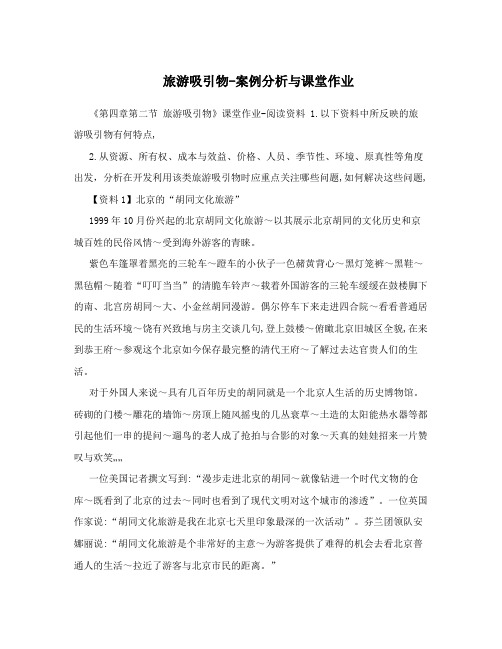
旅游吸引物-案例分析与课堂作业《第四章第二节旅游吸引物》课堂作业-阅读资料 1.以下资料中所反映的旅游吸引物有何特点,2.从资源、所有权、成本与效益、价格、人员、季节性、环境、原真性等角度出发,分析在开发利用该类旅游吸引物时应重点关注哪些问题,如何解决这些问题, 【资料1】北京的“胡同文化旅游”1999年10月份兴起的北京胡同文化旅游~以其展示北京胡同的文化历史和京城百姓的民俗风情~受到海外游客的青睐。
紫色车篷罩着黑亮的三轮车~蹬车的小伙子一色赭黄背心~黑灯笼裤~黑鞋~黑毡帽~随着“叮叮当当”的清脆车铃声~载着外国游客的三轮车缓缓在鼓楼脚下的南、北宫房胡同~大、小金丝胡同漫游。
偶尔停车下来走进四合院~看看普通居民的生活环境~饶有兴致地与房主交谈几句,登上鼓楼~俯瞰北京旧城区全貌,在来到恭王府~参观这个北京如今保存最完整的清代王府~了解过去达官贵人们的生活。
对于外国人来说~具有几百年历史的胡同就是一个北京人生活的历史博物馆。
砖砌的门楼~雕花的墙饰~房顶上随风摇曳的几丛衰草~土造的太阳能热水器等都引起他们一串的提问~遛鸟的老人成了抢拍与合影的对象~天真的娃娃招来一片赞叹与欢笑……一位美国记者撰文写到:“漫步走进北京的胡同~就像钻进一个时代文物的仓库~既看到了北京的过去~同时也看到了现代文明对这个城市的渗透”。
一位英国作家说:“胡同文化旅游是我在北京七天里印象最深的一次活动”。
芬兰团领队安娜丽说:“胡同文化旅游是个非常好的主意~为游客提供了难得的机会去看北京普通人的生活~拉近了游客与北京市民的距离。
”【资料2】失韵的周庄1988年~为了开发旅游~周庄“告别摆渡”~建了一座水泥大桥~从此旅游客车长驱直入。
桥~破坏了周庄的原生态。
1994年~受一家公司数千万元的投资吸引~周庄兴建一座“全福寺”~阮仪三教授知道后~大骂:假古董。
最大的危机~是去年一条环城公路要穿周庄而过~阮教授在等地领导面前大发雷霆:“如果要造~我就躺到公路上~与周庄共存亡:”所幸~在多位文物专家的疾呼之下~这条路终于戛然而止。
旅游经济学同步习题及答案 精品

绪论一、填空题1、旅游经济活动中旅游产品需求与供给这一内在矛盾,其外在表现为和与旅游目的地国家或地区政府三者之间利益上的矛盾。
2、旅游产品与的矛盾始终贯穿于旅游经济活动的始终,它决定了旅游经济学的研究对象不同于其他经济学。
3、世界上第一家旅行社是年成立的托马斯·库克旅行社。
二、名词解释1、旅游经济学:三、单项选择题1、旅游经济学研究的出发点是()A、旅游产品B、旅游供求关系C、旅游经济效益D、旅游经济活动2、我国北国的茫茫雪原,山青水秀的“鱼米之乡”┅┅这些令旅游者为之神往的旅游胜地,是因为受()所吸引。
A、旅游资源的多样性B、旅游资源的独特性C、旅游资源的民族性D、旅游资源的地域性3、以下()项是旅游经济活动产生的基础。
A、英国出现产业革命B、近代商品生产和商品交换的长期发展C、世界范围城市化步伐的加快D、世界人口的迅速增长4、旅游业属于()A.第一产业B.第二产业C.第三产业D.第四产业5、以下关于旅游经济运行特点的描述,( D )是错误的。
A.一次集中,多次消费 B.所有权不发生转移C.物流与商流分离 D.使用权不发生转移四、多项选择题1、旅游经济活动的主体是()A.旅游者B.旅游经营者C.旅游需求D.旅游供给五、判断题()1、我国的东部地区是旅游冷点地区,但该地区旅游资源丰富,民族文化特色浓。
()2、旅游饭店的主要功能是为旅游者组合和提供旅游活动中所需要的旅游吸引物、设施和服务。
()3、人们为了生活生存而远走他乡的行为也是旅游活动。
六、简答题1、二战后,旅游经济活动的发展有哪些特点?2、简述旅游经济学的研究内容。
3、旅游经济学的特点是什么?习题答案——绪论一、填空题1、旅游者旅游产品经营者旅游目的地国家或地区政府2、需求供给3、 1845二、名词解释1、旅游经济学:是现代经济学的一个分支,是以经济学的一般理论为指导,研究旅游经济活动中各种经济现象、经济关系和经济规律的学科。
三、单项选择题1、D2、D3、B4、C5、D四、多项选择题1、AB五、判断题1、×2、×3、×六、简答题1、答:(1)大众性(2)全球性(3)规范性(4)持续性2、答:(1)旅游产品的开发(生产)与供给;(2)旅游需求及旅游供求的矛盾运动和调节机制;(3)旅游产品消费;(4)旅游市场及开拓策略;(5)旅游收入、成本及效益;(6)旅游经济结构及可持续发展。
刍议我国旅游吸引物的开发

刍议我国旅游吸引物的开发摘要:旅游吸引物是吸引旅游者前往旅游目的地的重要因素,研究旅游吸引物的开发对我国旅游业发展起到非常重要的作用。
本文对旅游吸引物的概念及内涵、旅游吸引物的作用、旅游吸引物开发的方向进行了分析,并就不同旅游吸引物开发中需要注意的问题进行了探讨。
关键词:旅游;旅游吸引物;开发方向随着科学技术的快速发展,信息传播的途径越来越多,传播的范围也越来越广。
人们可以通过简便、快捷的方式找到并了解自己所感兴趣的知识及信息。
这也使得更多的旅游者(潜在旅游者)变得日益理智与成熟,使得他们在选择旅游目的地、消费旅游产品时更有方向性、目的性。
面对这些理智、成熟的旅游者们,“什么能吸引他们?”成为摆在业界专家学者面前一个迫切需要解决的问题。
其中“旅游吸引物”及“旅游吸引物的开发”成为大家关注的重点和热点。
一、旅游吸引物的概念对于什么是旅游吸引物,国内外不同的专家学者从不同的角度出发给出了各自的说法,到目前为止,没有被业界普遍接受的统一说法,但都承认旅游吸引物不仅仅包括景点景区等重要的旅游资源,它涵盖广泛,内容丰富。
笔者认为,旅游吸引物是能够吸引旅游者和管理者的所有因素的有效组合。
我们可以从3个层次理解这个概念:一是旅游吸引物必须能够吸引旅游者前去参观、体验;二是旅游吸引物必须能够让经营者和管理者(政府)投入人力、财力和物力以保护、保持或增强其吸引力;三是旅游吸引物先天自身的吸引力和后天附加的吸引力要能天衣无缝的很好结合并产生综合的多层次的强烈的吸引场,给旅游者带来超值的旅游感受。
二、旅游吸引物的作用旅游吸引物对一个国家、一个地区旅游业的发展起到了至关重要的作用,可以说没有了旅游吸引物,那么该地区的旅游业就是无源之水,无本之木,更无从谈起竞争,谈起发展。
旅游吸引物的作用概括起来主要有两方面:一是吸引旅游者、激发旅游者的旅游动机,进而影响其旅游行为,弃其它旅游目的地而选择我们作为其旅游目的地。
这是旅游吸引物最主要也是最重要的作用。
旅游吸引物名词解释
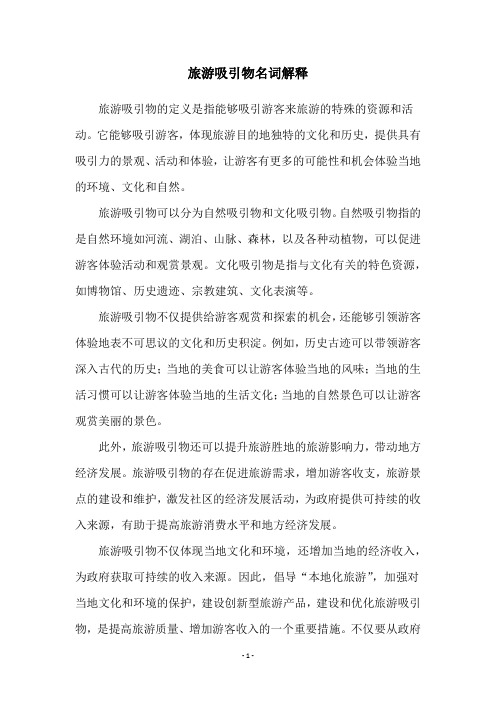
旅游吸引物名词解释旅游吸引物的定义是指能够吸引游客来旅游的特殊的资源和活动。
它能够吸引游客,体现旅游目的地独特的文化和历史,提供具有吸引力的景观、活动和体验,让游客有更多的可能性和机会体验当地的环境、文化和自然。
旅游吸引物可以分为自然吸引物和文化吸引物。
自然吸引物指的是自然环境如河流、湖泊、山脉、森林,以及各种动植物,可以促进游客体验活动和观赏景观。
文化吸引物是指与文化有关的特色资源,如博物馆、历史遗迹、宗教建筑、文化表演等。
旅游吸引物不仅提供给游客观赏和探索的机会,还能够引领游客体验地表不可思议的文化和历史积淀。
例如,历史古迹可以带领游客深入古代的历史;当地的美食可以让游客体验当地的风味;当地的生活习惯可以让游客体验当地的生活文化;当地的自然景色可以让游客观赏美丽的景色。
此外,旅游吸引物还可以提升旅游胜地的旅游影响力,带动地方经济发展。
旅游吸引物的存在促进旅游需求,增加游客收支,旅游景点的建设和维护,激发社区的经济发展活动,为政府提供可持续的收入来源,有助于提高旅游消费水平和地方经济发展。
旅游吸引物不仅体现当地文化和环境,还增加当地的经济收入,为政府获取可持续的收入来源。
因此,倡导“本地化旅游”,加强对当地文化和环境的保护,建设创新型旅游产品,建设和优化旅游吸引物,是提高旅游质量、增加游客收入的一个重要措施。
不仅要从政府政策和项目的实施层面着手,还需要地方政府和社会企业开展多角度、多领域的合作,加强文化资源的开发、利用和保护,提升景区的吸引力,提高服务质量。
总之,旅游吸引物是旅游发展的重要支柱,其发挥的重要作用几乎可以得到普遍认可。
不仅是体现当地文化和环境的象征,还能够增加当地的经济收入和政府的可持续收入来源。
因此,政府和旅游业者都应对旅游吸引物加以重视,努力丰富它们,以提高旅游效益和发展质量。
旅游吸引物名词解释
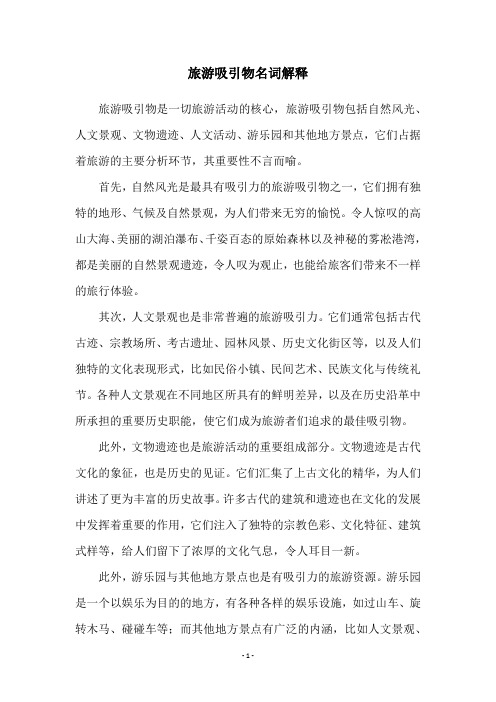
旅游吸引物名词解释旅游吸引物是一切旅游活动的核心,旅游吸引物包括自然风光、人文景观、文物遗迹、人文活动、游乐园和其他地方景点,它们占据着旅游的主要分析环节,其重要性不言而喻。
首先,自然风光是最具有吸引力的旅游吸引物之一,它们拥有独特的地形、气候及自然景观,为人们带来无穷的愉悦。
令人惊叹的高山大海、美丽的湖泊瀑布、千姿百态的原始森林以及神秘的雾凇港湾,都是美丽的自然景观遗迹,令人叹为观止,也能给旅客们带来不一样的旅行体验。
其次,人文景观也是非常普遍的旅游吸引力。
它们通常包括古代古迹、宗教场所、考古遗址、园林风景、历史文化街区等,以及人们独特的文化表现形式,比如民俗小镇、民间艺术、民族文化与传统礼节。
各种人文景观在不同地区所具有的鲜明差异,以及在历史沿革中所承担的重要历史职能,使它们成为旅游者们追求的最佳吸引物。
此外,文物遗迹也是旅游活动的重要组成部分。
文物遗迹是古代文化的象征,也是历史的见证。
它们汇集了上古文化的精华,为人们讲述了更为丰富的历史故事。
许多古代的建筑和遗迹也在文化的发展中发挥着重要的作用,它们注入了独特的宗教色彩、文化特征、建筑式样等,给人们留下了浓厚的文化气息,令人耳目一新。
此外,游乐园与其他地方景点也是有吸引力的旅游资源。
游乐园是一个以娱乐为目的的地方,有各种各样的娱乐设施,如过山车、旋转木马、碰碰车等;而其他地方景点有广泛的内涵,比如人文景观、历史遗迹、动植物自然等,都具有很高的旅游吸引力。
旅游吸引物的存在,不仅仅让旅游活动多样化,还可以为国家带来巨大的经济效益,激发社会活力,促进国际文化交流,拓展和谐交往之路,努力构建更加美好的未来。
因此,政府和企业应该加大对旅游吸引物的开发力度,努力充实旅游资源,提高旅游活动的品质,发展更加繁荣的旅游业。
旅游吸引物要素浅析
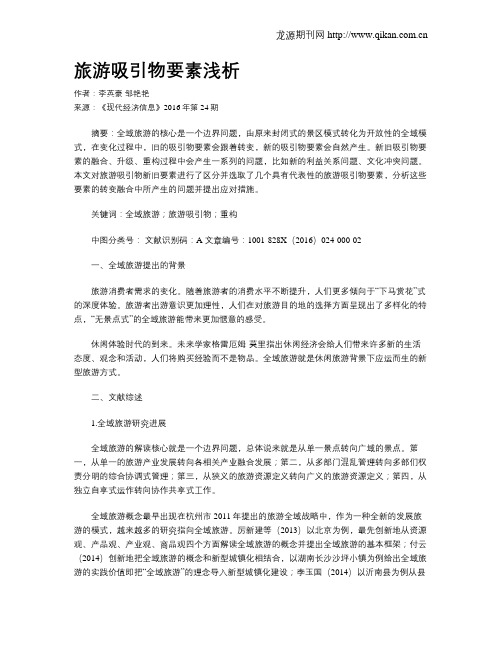
旅游吸引物要素浅析作者:李英豪邹艳艳来源:《现代经济信息》2016年第24期摘要:全域旅游的核心是一个边界问题,由原来封闭式的景区模式转化为开放性的全域模式,在变化过程中,旧的吸引物要素会跟着转变,新的吸引物要素会自然产生。
新旧吸引物要素的融合、升级、重构过程中会产生一系列的问题,比如新的利益关系问题、文化冲突问题。
本文对旅游吸引物新旧要素进行了区分并选取了几个具有代表性的旅游吸引物要素,分析这些要素的转变融合中所产生的问题并提出应对措施。
关键词:全域旅游;旅游吸引物;重构中图分类号:文献识别码:A 文章编号:1001-828X(2016)024-000-02一、全域旅游提出的背景旅游消费者需求的变化。
随着旅游者的消费水平不断提升,人们更多倾向于“下马赏花”式的深度体验。
旅游者出游意识更加理性,人们在对旅游目的地的选择方面呈现出了多样化的特点,“无景点式”的全域旅游能带来更加惬意的感受。
休闲体验时代的到来。
未来学家格雷厄姆·莫里指出休闲经济会给人们带来许多新的生活态度、观念和活动,人们将购买经验而不是物品。
全域旅游就是休闲旅游背景下应运而生的新型旅游方式。
二、文献综述1.全域旅游研究进展全域旅游的解读核心就是一个边界问题,总体说来就是从单一景点转向广域的景点。
第一,从单一的旅游产业发展转向各相关产业融合发展;第二,从多部门混乱管理转向多部们权责分明的综合协调式管理;第三,从狭义的旅游资源定义转向广义的旅游资源定义;第四,从独立自享式运作转向协作共享式工作。
全域旅游概念最早出现在杭州市2011年提出的旅游全域战略中,作为一种全新的发展旅游的模式,越来越多的研究指向全域旅游。
厉新建等(2013)以北京为例,最先创新地从资源观、产品观、产业观、商品观四个方面解读全域旅游的概念并提出全域旅游的基本框架;付云(2014)创新地把全域旅游的概念和新型城镇化相结合,以湖南长沙沙坪小镇为例给出全域旅游的实践价值即把“全域旅游”的理念导入新型城镇化建设;李玉国(2014)以沂南县为例从县级行政区的范围内探讨了旅游产业的全域模式,并从全区域、全时域、全领域、全业域、全地域的角度提出沂南县全新的旅游发展模式;李红(2016)以安徽霍山为例探讨了全域模式下县域旅游的发展研究;曾祥辉(2015)以永定县为例研究了全域视角下旅游发展的未来方向与思路;樊文斌(2015)从全域的视角下给出了大连旅游的专项规划。
第4讲 旅游吸引物

一、旅游吸引物的概念及其内涵、属性
面粉
面包 小麦 酒
(旅游媒介)
认同
(旅游经营者)
旅游者
审美 消费
图5.1 旅游资源、旅游吸引物与旅游产品的关系
(一)旅游吸引物的概念
旅游吸引物包括旅游者、旅游地/景点、标 识物或形象,实质上反映了潜在的旅游需 求者通过旅游信息系统获得核心吸引物的 过程。
旅游吸引物需要游客付出一定的努力和代 价来获得,因而是绝对价值(某种稀缺的 客观属性)、符号价值(某种社会价值和 理想的意义建构)和消费价值(旅游者的 获得)的结合。
二、旅游吸引物的社会建构
旅游客体的符号化过程包括: 1、通过大众媒体、大众传播和教育等知识 传播过程,使旅游客体成为社会的价值与 理想的承载体。 2、旅游开发过程中,经营者借助市场营销 手段而树立某一旅游客体的形象,提升其 旅游价值,赋予其神圣意义。
3.交通工具的快速移动带来了新的观看视角, 景观成为快速移动的画幅,催生了自驾兜 风游。
4.社会生活的美感化成为新的追求,“视觉 消费”流行,“主题化”成为吸引物的主 要标志(台中市中友百货)。
5. 新奇、虚构的刺激物对人们产生“白日 梦”的情感影响(迪斯尼乐园)。
总结
旅游吸引物不但有物理寿命,且有社会寿 命。 影响旅游地生命周期的不但有其物理特性 的变化,更重要的是其社会文化属性是否 符合当时的主流社会价值观。 对旅游吸引物的评级,也不能离开其符号 属性。(如重点文物保护单位并非一定会 受消费者青睐)
(二)旅游吸引物的分类 核心吸引物(物质与非物质) 特殊游客(构成景观的游客) 有效的旅游运营方式(网络信息平台、贴 心营销服务)
(三)旅游吸引物的属性
旅游吸引物名词解释
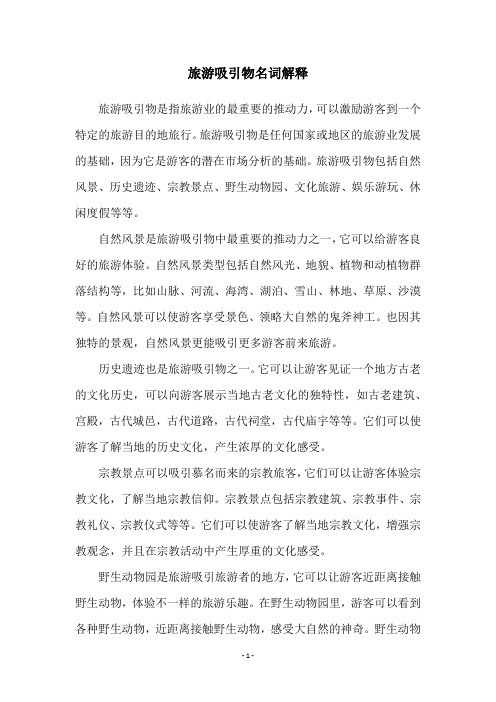
旅游吸引物名词解释旅游吸引物是指旅游业的最重要的推动力,可以激励游客到一个特定的旅游目的地旅行。
旅游吸引物是任何国家或地区的旅游业发展的基础,因为它是游客的潜在市场分析的基础。
旅游吸引物包括自然风景、历史遗迹、宗教景点、野生动物园、文化旅游、娱乐游玩、休闲度假等等。
自然风景是旅游吸引物中最重要的推动力之一,它可以给游客良好的旅游体验。
自然风景类型包括自然风光、地貌、植物和动植物群落结构等,比如山脉、河流、海湾、湖泊、雪山、林地、草原、沙漠等。
自然风景可以使游客享受景色、领略大自然的鬼斧神工。
也因其独特的景观,自然风景更能吸引更多游客前来旅游。
历史遗迹也是旅游吸引物之一。
它可以让游客见证一个地方古老的文化历史,可以向游客展示当地古老文化的独特性,如古老建筑、宫殿,古代城邑,古代道路,古代祠堂,古代庙宇等等。
它们可以使游客了解当地的历史文化,产生浓厚的文化感受。
宗教景点可以吸引慕名而来的宗教旅客,它们可以让游客体验宗教文化,了解当地宗教信仰。
宗教景点包括宗教建筑、宗教事件、宗教礼仪、宗教仪式等等。
它们可以使游客了解当地宗教文化,增强宗教观念,并且在宗教活动中产生厚重的文化感受。
野生动物园是旅游吸引旅游者的地方,它可以让游客近距离接触野生动物,体验不一样的旅游乐趣。
在野生动物园里,游客可以看到各种野生动物,近距离接触野生动物,感受大自然的神奇。
野生动物园还可以提供有关野生动物的知识,让游客获得更多关于野生动物的知识,增强游客对野生动物的兴趣,促进野生动物保护意识的普及。
文化旅游可以吸引海外游客前来旅游,感受另一个文化。
文化旅游可以让游客充分了解当地文化,体验当地文化,比如吃当地美食、购买当地特色商品、参加当地特色活动等等,可以让游客体验当地文化的独特性,并在旅行中获得更多乐趣。
娱乐游玩可以吸引游客前来旅游,娱乐游玩包括游乐园、水上乐园、游艇、帆船、滑水、垂钓等各种游乐项目。
它们可以让游客充分体验自然界的美好,追求快乐,通过游玩可以帮助游客放松身心,活力十足地游玩。
简析旅游产品_旅游资源及旅游吸引物间的关系
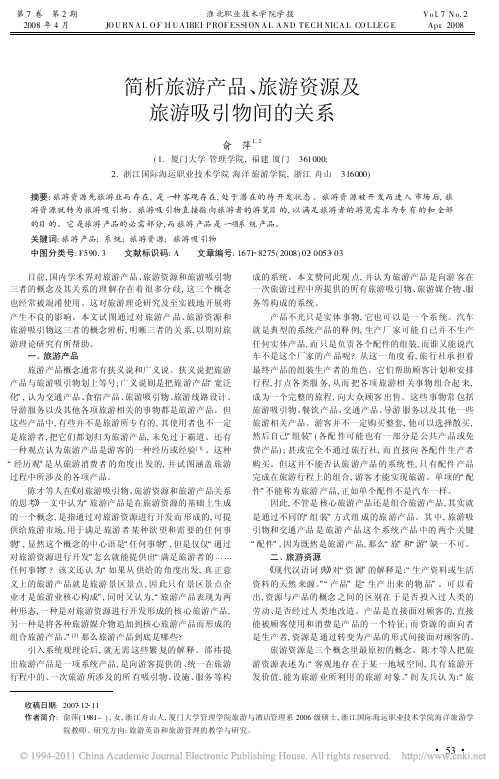
淮北职业技术学院学报 JO U RN A L O F H U A IBEI P ROF ESSI ON A L A N D T ECH NICA L CO L LEG E
V o l. 7 N o. 2 Apr 2008
简析旅游产品、 旅游资源及 旅游吸引物间的关系
俞 萍
1, 2
( 1. 厦门6000)
2. 浙江国际海运职业技术学院 海洋 旅游学院 , 浙江 舟山
摘要 : 旅游资源先旅游业而存在 , 是一种客观存在 , 处于 潜在的待 开发状态 。 旅游资 源被开 发而进入 市场后 , 旅 游资源就转为旅游吸引物 。 旅游吸引物直接指向旅游者的游览目的 , 以满足旅游者的游览需求为专有 的和全部 的目的 。 它是旅游产品的必需部分 , 而旅游产品是一项系 统产品 。 关键词 : 旅游产品 ; 系统 ; 旅游资源 ; 旅游吸引物 中图分类号 : F590. 3 文献标识码 : A 文章编号 : 1671 8275( 2008) 02 0053 03 成的系统。本文赞同此观 点 , 并认为 旅游产品 是向游 客在 一次旅游过程中所提供的所有旅游吸引物、 旅游媒介物、 服 务等构成的系统。 产品不光只是实体 事物 , 它也可 以是一 个系 统。汽车 就是典型的系统产品的释 例 , 生产厂 家可能 自己并 不生产 任何实体产品 , 而 只是负责各个配件的组装 , 而谁又能说汽 车不是这个厂家的产 品呢 ? 从这 一角度 看 , 旅 行社承 担着 最终产品的组装生产者的角色。它们帮助顾客计划和安排 行程 , 打点各类服 务 , 从而 把各项 旅游相 关事物 组合起 来 , 成为一个完整的旅程 , 向大 众顾客 出售。这些 事物常 包括 旅游吸引物、 餐饮 产品、 交通产品、 导游 服务以及其 他一些 旅游相关产品。游客并不一定购买整套 , 他可以选择散买 , 然后自己 组装 ( 各配 件可能 也有一 部分是 公共产 品或免 费产品 ) ; 甚或完全不通过 旅行社 , 而 直接向 各配件 生产者 购买。但这并不能否认旅 游产品 的系统 性 , 只 有配件 产品 完成在旅游行程上的组合 , 游客才能实现旅游。单项的 配 件 不能称为旅游 产品 , 正如单个配件不是汽车一样。 因此 , 不管是 核心旅游产品还是组合旅游产品 , 其实就 是通过不同的 组 装 方式组 成的旅 游产品。其 中 , 旅游吸 引物和交通产品 是 旅游 产品 这个 系统 产品 中的 两个 关键 配件 , 因为既然是旅游产 品 , 那么 旅 和 游 缺一不可。 二 、旅游资源 现代汉语词 典 对 资 源 的解释是 : 生产资料或生活 资料的天然 来源。 产品 是 生产 出来 的物 品 。可 以看 出 , 资源与产品的概念 之间的 区别在 于是否 投入过 人类的 劳动、 是否经过人 类地改造。产品是直接面对顾客的 , 直接 能被顾客使用和消费是产 品的一 个特征 ; 而 资源的 面向者 是生产者 , 资源是 通过转变为产品的形式间接面对顾客的。 旅游资源是三个概念里最原初的概念。陈才等人把旅 游资源表述为 : 客观地存 在于某 一地域 空间 , 具有 旅游开 发价值 , 能为旅游 业所利用 的旅游 对象。 阎 友兵认 为 : 旅
旅游资源和旅游吸引物的概念及分类【可修改文字】

可编辑修改精选全文完整版1、旅游资源旅游资源是我国旅游界中经常用到的概念,然而,这个概念在欧美国家却很少提及。
在大量的欧美旅游学术文献中,最常用到的和旅游资源概念接近的词是“旅游吸引物”(Tourism Attraction)。
不管这两个词本身有何差异,它们在概念或是定义上的众说纷纭却是极其相似的。
杨振之(1997)认为,旅游资源的结构表现为旅游的三大要素:主体、客体和介体的相互吸引。
因此,所谓旅游资源,“除了自然资源和人文资源外,对于旅游者来说,就是旅游目的地及有关旅游的一切服务和设施;对于旅游地来说,就是客观存在着的客源市场。
旅游资源是关于旅游的主体、客体、介体相互间吸引性的总和”杨振之(2002)又认为,旅游资源包含的内容十分广泛,它应包括以下几大类:1、自然旅游资源;2、人文旅游资源;3、服务旅游资源;4、旅游设施和基础设施资源;5、其他新兴的资源类型。
因此,旅游资源这一概念在逻辑上分为内涵和外延两部分,传统的定义,即自然旅游资源和人文旅游资源是它的内涵、内核。
而随着旅游业向深度发展,旅游资源的外延将越来越宽泛,类型将越来越多。
实践已经证明了这一道理,如果仍然将它限制在一个传统的、狭小的范围内,就会发现,我们的观念跟不上旅游业的发展。
今后还将有很多意想不到的资源成为旅游资源的一个部分。
2003年5月开始推行的《旅游资源分类、调查和评价》国家标准(GB/T18972一2003)将旅游资源定义为“自然界和人类社会凡能对旅游者产生吸引力,可以为旅游业开发利用,并可产生经济效益、社会效益和环境效益的各种事物和因素”。
综合这些定义,可以看到,它们的共同点正如孙文昌(1997)所说,“那就是强调了旅游资源具有吸引旅游者这一属性,我们称之为旅游资源的理论核心”。
它们之间的差异主要表现在旅游资源包括的内容方面。
有些定义认为旅游资源主要局限于旅游目的地具有的自然和人文旅游资源,有些定义则认为旅游资源的定义应当宽泛一些,可以涵盖劳务和设施等,还有的定义挣脱旅游目的地的地域束缚,从旅游系统的层面上来探讨旅游资源的内容。
旅游经济学_试题集(含答案)
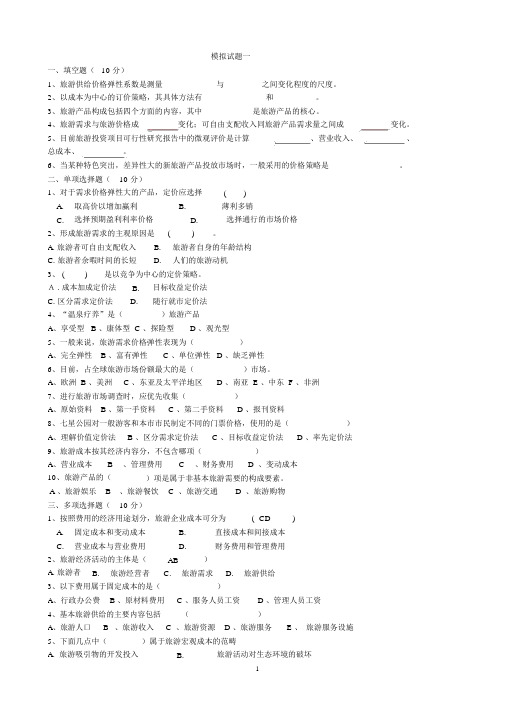
模拟试题一一、填空题(10 分)1、旅游供给价格弹性系数是测量_________与 ________之间变化程度的尺度。
2、以成本为中心的订价策略,其具体方法有__________和 _________。
3、旅游产品构成包括四个方面的内容,其中_______是旅游产品的核心。
4、旅游需求与旅游价格成变化;可自由支配收入同旅游产品需求量之间成变化。
5、目前旅游投资项目可行性研究报告中的微观评价是计算、营业收入、、总成本、。
6、当某种特色突出,差异性大的新旅游产品投放市场时,一般采用的价格策略是_______。
二、单项选择题(10 分)1、对于需求价格弹性大的产品,定价应选择()A.取高价以增加赢利B.薄利多销C.选择预期盈利利率价格D.选择通行的市场价格2、形成旅游需求的主观原因是()。
A. 旅游者可自由支配收入B.旅游者自身的年龄结构C. 旅游者余暇时间的长短D.人们的旅游动机3、 ()是以竞争为中心的定价策略。
A . 成本加成定价法 B.目标收益定价法C. 区分需求定价法D.随行就市定价法4、“温泉疗养”是()旅游产品A、享受型 B 、康体型 C 、探险型 D 、观光型5、一般来说,旅游需求价格弹性表现为()A、完全弹性 B 、富有弹性 C 、单位弹性 D 、缺乏弹性6、目前,占全球旅游市场份额最大的是()市场。
A、欧洲 B 、美洲 C 、东亚及太平洋地区 D 、南亚 E 、中东 F 、非洲7、进行旅游市场调查时,应优先收集()A、原始资料 B 、第一手资料 C 、第二手资料 D 、报刊资料8、七星公园对一般游客和本市市民制定不同的门票价格,使用的是()A、理解价值定价法 B 、区分需求定价法 C 、目标收益定价法 D 、率先定价法9、旅游成本按其经济内容分,不包含哪项()A、营业成本B、管理费用C、财务费用 D 、变动成本10、旅游产品的()项是属于非基本旅游需要的构成要素。
A 、旅游娱乐B、旅游餐饮 C 、旅游交通 D 、旅游购物三、多项选择题(10 分)1、按照费用的经济用途划分,旅游企业成本可分为( CD)A.固定成本和变动成本B.直接成本和间接成本C.营业成本与营业费用D.财务费用和管理费用2、旅游经济活动的主体是(AB)A. 旅游者B.旅游经营者C.旅游需求D.旅游供给3、以下费用属于固定成本的是()A、行政办公费 B 、原材料费用 C 、服务人员工资 D 、管理人员工资4、基本旅游供给的主要内容包括()A、旅游人口B、旅游收入 C 、旅游资源 D 、旅游服务 E 、旅游服务设施5、下面几点中()属于旅游宏观成本的范畴A. 旅游吸引物的开发投入B.旅游活动对生态环境的破坏C. 高机会成本的损失D.旅游基础设施的投入四、名词解释(20 分)1.旅游经济学:2.旅游经济效益:3.旅游需求规律:4.旅游市场(狭义)5.单项旅游产品五、判断题( 5 分)() 1、如果某一市场主体相对市场占有率等于 1,则表明该市场主体在市场竞争中占有最大的份额。
旅游景区吸引物简答题。

旅游景区吸引物简答题。
旅游景区吸引物是指能够引起游客兴趣和参观欲望的各类景观和活动。
在我国,旅游景区吸引物种类繁多,大致可分为自然景观、人文景观和文化创意景观。
一、旅游景区吸引物的概念与分类1.自然景观:如山水风光、动植物、地貌等自然现象,如九寨沟、张家界等。
2.人文景观:如历史遗迹、建筑、民俗等人类活动留下的痕迹,如故宫、长城等。
3.文化创意景观:如主题公园、雕塑公园、艺术小镇等,如上海迪士尼、深圳世界之窗等。
旅游景区吸引物不仅具有观赏价值,让人们领略大自然和人类智慧的结晶,还具有教育价值,传播历史文化知识,促进民族认同感。
同时,旅游景区吸引物还具有显著的经济价值和社会价值,为地区经济发展注入活力,提高人民生活水平,促进社会和谐。
二、旅游景区吸引物的功能与价值1.观赏价值:旅游景区吸引物为游客提供了美丽的风光和独特的人文景观,满足游客的审美需求。
2.教育价值:旅游景区吸引物传播历史文化知识,提高游客的文化素养,培养民族自豪感。
3.经济价值:旅游景区吸引物带动旅游产业链发展,创造就业岗位,促进地区经济增长。
4.社会价值:旅游景区吸引物促进地区文化交流,增进民族团结,提高人民生活水平。
尽管我国旅游景区资源丰富,但开发程度不一,品质参差不齐,同质化竞争严重。
同时,部分地区在开发过程中忽视生态环境保护,导致资源浪费和环境恶化。
为提升旅游景区吸引物竞争力,我们需要采取以下策略:三、我国旅游景区吸引物的现状与问题1.资源丰富,分布不均:我国旅游景区资源丰富,但南北东西分布不均,部分地区资源匮乏。
2.开发程度不一,品质参差不齐:部分景区过度开发,导致景观破坏;部分景区则开发不足,资源闲置。
3.同质化竞争严重:众多旅游景区提供类似的产品和服务,难以满足游客多样化需求。
4.生态环境保护与可持续发展问题:部分景区在开发过程中忽视生态环境保护,导致资源浪费和环境恶化。
四、提升旅游景区吸引物竞争力的策略1.突出特色,差异化发展:旅游景区应明确自身特色,提供差异化产品和服务,满足游客多样化需求。
旅游吸引物

餐饮住宿:
北京作为中国的政治中 心,经济发展迅速, 因而餐饮住宿行业发 展相对完善,从快捷 酒店到六星级的大酒 店,适合各个类型的 旅游人群 奠定了会展旅游的发展
会议型酒店
ቤተ መጻሕፍቲ ባይዱ
会议型酒店的设施完善,各种类型的场地规模,成为了会展旅 游发展的必要条件
狭义下的旅游吸引物
会展与旅游的关系
促进
紧密相连,相辅相成,互为补充
会展旅游 是借助举办国际会议、研讨会、论坛等会务活动
以及各种展览会而开展的旅游形式,是北京市旅游产品开 发的一个重点。
北京每年举办的各类会务和展览占全国的80%~ 85%,会展旅游者在北京市游客中的数量和消费 比例逐年上升。
会展旅游 作为一种把会展活动和旅游相结合的新兴旅游方
狭义的旅游吸引物
一般是指有形的旅游资 源,包括自然旅游资源 和人文旅游资源;
广义的旅游吸引物
旅游服务:
北京旅游咨询站
北京旅游咨询服务中心遍布北京18个城区及首都机 场、北京火车站。为旅游、出行提供专业便捷的咨 询服务。
风俗特产 北京是中国四大古都 之一。有很多地方特色的 民风习俗:北京小吃、京 剧、京韵大鼓、相声、舞 台剧、铁板快书、景泰蓝、 牙雕、毛猴、漆雕、赛蝈 蝈和蝈蝈笼、吹糖人、捏 面人等等。
• 一、自然景观:
北京是全球拥有世界遗产(6处)最多的城市,是全球首 个拥有世界地质公园的首都城市。北京旅游资源丰富,对 外开放的旅游景点达200多处,有世界上最大的皇宫紫禁 城、祭天神庙天坛、皇家园林北海公园、颐和园和圆明园, 还有八达岭长城、慕田峪长城以及世界上最大的四合院恭 王府等名胜古迹。北京市共有文物古迹7309项,99处全 国重点文物保护单位(含长城和京杭大运河的北京段)、 326处市级文物保护单位、5处国家地质公园、15处国家 森林公园。
旅游吸引物名词解释

旅游吸引物名词解释
旅游吸引物指的是用来引起其他人参观旅游景点的动机或原因,它们是旅游行业的重要组成部分,因为它们可以帮助旅游业者制定出强有力的推广策略,吸引更多的游客来消费。
一般来说,旅游吸引物可以分为客观性和主观性两类。
客观性旅游吸引物包括景观、地理、自然环境,这些都是指一些具有自然特性的旅游景点,如湖泊、山脉、森林等,这些自然景观吸引着旅客来此地寻求休闲和放松。
另外,地理因素也会影响到旅游者的选择,有些地方会因其距离、便捷程度等因素而受到旅客的青睐;另外,自然环境也是旅客出游的重要考量因素,例如气候,假如一个地方温暖怡人,空气新鲜、饮用水也较为清洁,这些都会吸引更多的游客到此地游玩。
主观性旅游吸引物指的是非客观的旅游景点,包括风俗、人文、历史故事、文化特色、流行文化、特色美食等,这些都是指旅客来到一个地方所能体验到的文化、社会以及宗教认同感等。
如人们去台湾游玩,会受到当地的建筑、服装、饮食等的文化影响,且深入了解台湾人的生活习俗;另外,历史故事也是游客心中的激情因素,比如旅游者去参观某个古城,即使那里可能已经荒废多年,但仍然可以从中获得很多关于过去的见解,为游客带来极大的刺激。
总之,旅游吸引物是一种极为重要的旅游活动,依靠这些吸引力,旅游业者就可以帮助游客实现他们的游程愿望,并让游客在这样的活动中得到心理和情感的满足。
所以,未来的旅游业者可以集中力量提
升景点的设施、设计更吸引人的旅游活动以及采用有效的营销策略,让游客可以体验到更多的旅游乐趣。
旅游吸引物分类

旅游吸引物分类一、自然景观类1. 雪山雪山是指山顶积雪覆盖的山峰,常年被白雪覆盖,给人以美丽壮观的感觉。
徒步登山、滑雪等都是雪山旅游的热门项目,例如喜马拉雅山、阿尔卑斯山等。
2. 瀑布瀑布是指水流从较高的地方垂直落下形成的景观。
瀑布的水流汹涌,冲击力强,给人以壮观的视觉冲击力。
世界上有许多著名的瀑布,如尼亚加拉大瀑布、维多利亚瀑布等。
3. 珊瑚礁珊瑚礁是在海底形成的岩石结构,由珊瑚动物的骨骼堆积而成。
珊瑚礁生态系统丰富多样,吸引了众多潜水爱好者。
例如大堡礁是世界上最大的珊瑚礁之一。
二、文化遗产类1. 古建筑古建筑是指历史悠久、具有独特建筑风格的建筑物。
这些建筑物通常融合了当地的传统文化和建筑技艺,具有观赏和研究价值。
例如中国的故宫、埃及的金字塔等。
2. 遗址遗址是指古代文明留下的遗迹或遗址,有着重要的历史、文化和科学价值。
游览古代遗址可以了解古代文明的发展历程。
例如希腊的雅典卫城、古巴的哈瓦那古城等。
3. 博物馆博物馆是收藏、展示和研究文化、艺术和科学等方面的藏品和展览的场所。
博物馆通常有各种主题,如艺术博物馆、历史博物馆、科技博物馆等。
例如大英博物馆、卢浮宫等。
三、风景名胜类1. 古镇古镇是指保留了古代建筑和传统文化的小镇。
这些小镇通常有着独特的历史和文化底蕴,给人一种时光倒流的感觉。
例如中国的丽江古镇、意大利的锡耶纳古镇等。
2. 名山名山是指因山势险峻、景色秀丽而著名的山峰。
名山常常与文化和历史相结合,具有重要的历史和文化价值。
例如中国的黄山、日本的富士山等。
3. 沙漠沙漠是指干旱地区的地貌类型,由于缺乏水源和植被,给人以荒凉和神秘的感觉。
沙漠旅游可以体验驼队穿越、沙漠滑板等特色项目。
例如撒哈拉沙漠、蒙古的戈壁沙漠等。
四、动物园类1. 野生动物园野生动物园是指模拟野生环境,供观赏和保护野生动物的场所。
游客可以近距离观察各种野生动物,了解它们的生活习性和保护意义。
例如肯尼亚的马赛马拉野生动物保护区、中国的大熊猫保护区等。
旅游景区吸引物简答题。
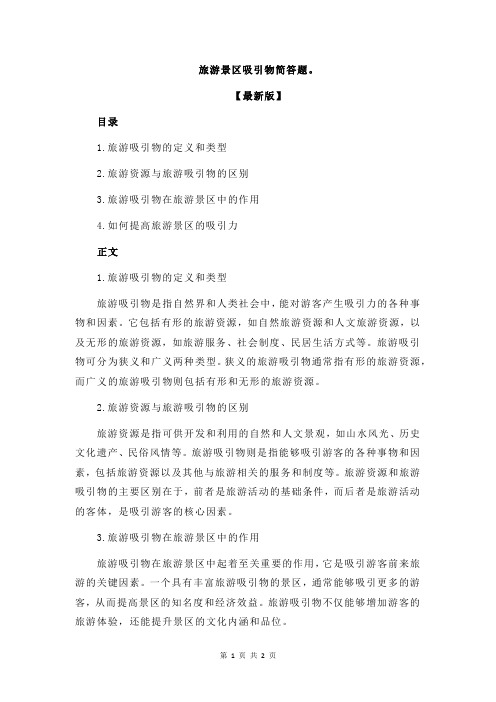
旅游景区吸引物简答题。
【最新版】目录1.旅游吸引物的定义和类型2.旅游资源与旅游吸引物的区别3.旅游吸引物在旅游景区中的作用4.如何提高旅游景区的吸引力正文1.旅游吸引物的定义和类型旅游吸引物是指自然界和人类社会中,能对游客产生吸引力的各种事物和因素。
它包括有形的旅游资源,如自然旅游资源和人文旅游资源,以及无形的旅游资源,如旅游服务、社会制度、民居生活方式等。
旅游吸引物可分为狭义和广义两种类型。
狭义的旅游吸引物通常指有形的旅游资源,而广义的旅游吸引物则包括有形和无形的旅游资源。
2.旅游资源与旅游吸引物的区别旅游资源是指可供开发和利用的自然和人文景观,如山水风光、历史文化遗产、民俗风情等。
旅游吸引物则是指能够吸引游客的各种事物和因素,包括旅游资源以及其他与旅游相关的服务和制度等。
旅游资源和旅游吸引物的主要区别在于,前者是旅游活动的基础条件,而后者是旅游活动的客体,是吸引游客的核心因素。
3.旅游吸引物在旅游景区中的作用旅游吸引物在旅游景区中起着至关重要的作用,它是吸引游客前来旅游的关键因素。
一个具有丰富旅游吸引物的景区,通常能够吸引更多的游客,从而提高景区的知名度和经济效益。
旅游吸引物不仅能够增加游客的旅游体验,还能提升景区的文化内涵和品位。
4.如何提高旅游景区的吸引力提高旅游景区的吸引力,需要从以下几个方面入手:(1)丰富旅游资源:景区应该不断挖掘和开发新的旅游资源,包括自然景观、人文景观、民俗风情等,以满足游客的多样化需求。
(2)提升旅游服务质量:景区应提高旅游服务水平,包括住宿、餐饮、交通、导游等,以确保游客在旅游过程中的舒适度和满意度。
(3)举办特色活动:景区可以定期举办特色旅游活动,如文化节、音乐节、体育赛事等,以吸引游客参与和关注。
(4)加强景区宣传推广:景区应加大宣传力度,通过各种渠道向潜在游客传递景区的魅力和价值,以提高景区的知名度和美誉度。
(5)完善景区基础设施:景区应加强基础设施建设,如游客中心、停车场、卫生间等,以提高游客在景区内的游览体验。
《旅游吸引物第一节》课件

经过人工修建或开发的旅游景点,如主题公园、度假村、购物中心等。
文化旅游吸引物的例子
古代寺庙
古代寺庙展示着悠久的宗教与文 化传统,吸引着许多游客前来参 观和学习。
传统舞蹈表演
传统舞蹈表演展示了当地的舞蹈 艺术和文化,给观众带来了视觉 和音乐的双重享受。
历史博物馆
历史博物馆展示了丰富的历史文 物和艺术品,使游客能够深入了 解当地的历史和文化。
旅游吸引物第一节
旅游吸引物第一节PPT课件
介绍旅游吸引物
旅游吸引物是指吸引游客前来参观、旅游的特定地点、景点或景观。它们可以是自然的、文化的或通过人工发 展而成的。
旅游吸引物的分类
1 自然旅游吸引物
包括山脉、湖泊、海滩、瀑布等自然景观。
2 文化旅游吸引物
指那些与特定文化、历史或传统有关的地标、建筑、节日等。
总结和要点
吸引力
旅游吸引物应具备吸引力, 能够吸引游客的注意和兴趣。
多样性
趣。
可持续发展
通过合理规划和环境保护, 实现旅游吸引物的可持续发 展。
自然旅游吸引物的例子
壮丽的瀑布
壮丽的瀑布令人叹为观止,迷人 的水景吸引了许多游客来欣赏和 拍照。
壮丽的山脉
壮丽的山脉提供了绝佳的徒步和 登山机会,吸引了许多户外爱好 者。
宁静的湖泊
宁静的湖泊被郁郁葱葱的森林环 绕着,提供了休闲垂钓和划船的 机会。
基础设施和交通对旅游吸引物的影响
1 交通便利
良好的交通网络使游客更容易到达旅游吸引物,增加了游客数量。
2 基础设施改善
完善的基础设施如酒店、餐厅和公共设施,能够提供更好的游客体验。
3 环境保护
对旅游吸引物所在地的自然环境进行保护,确保可持续发展。
- 1、下载文档前请自行甄别文档内容的完整性,平台不提供额外的编辑、内容补充、找答案等附加服务。
- 2、"仅部分预览"的文档,不可在线预览部分如存在完整性等问题,可反馈申请退款(可完整预览的文档不适用该条件!)。
- 3、如文档侵犯您的权益,请联系客服反馈,我们会尽快为您处理(人工客服工作时间:9:00-18:30)。
Ability goals: 能力目标
Case study: 案例分析: 云南民族村 主题公园如 何走出困境
Reading Box: 阅读分 析:Virtual Reality虚拟 的真实
1. Tourist attraction旅游吸引物
我国通常将旅游吸引 物称为旅游资源。 旅游吸引物的定义: 凡是能够激发旅游者 的旅游动机,为旅游 业所利用,并由此而 产生经济效益和社会 效益的一切事物和现 象。
in the United States and China
Publicity and promotion of tourism resources 旅游资源个性化的宣传
四川:“熊猫故乡”(突出唯我独有、中外闻名的旅游吸引物)
新疆:“大漠风光、西域风情”(显示新疆独特的区域、地貌、民俗风情)
广西:“桂林山水甲天下”(沿用家喻户晓的千古名诗绝句) 深圳:“世界名城、中华之窗”(把城市特色与著名景区联为一体)
Learning objects: 学习目标
Describe the process of commercialization of tourist products and its presentation陈述旅游产品商品化的演进过程 以及不同表现 Have a break-down of the commercialization of cultures and its serious consequence分析文化商品化及其严重的后果
旅游吸引物的其他分类
地文景观类
按其发生学和形态学上的差异
生物景观类
水域风光类
旅游吸引物的其他分类
不可再生性旅游资
按资源的可持续利用潜力
再生性旅游资源
3.旅游吸引物的特性 Attraction attributes
Figure 1 Tourist attraction attributes
Public Non-profit Nodal Genuine Ownership Private Profit Areal Imitation
World fairs
Festival
Types:
(1) small and large (2) regular and irregular (3) single destination and multiple destination (4) classification
• Conference
讨论:How do you understand the implication of tourism resources?怎样理解旅 游资源的定义?
(1)作为旅游资源 必须有两个必备条件: 要能够激发旅游者的 旅游动机 要能够为旅游业所利 用
(2)作为现实的 旅游资源,必须要 能够通过对其利用 而产生经济效益和 社会效益
2. Classification of tourist attraction旅游吸引物的分类
自然旅游资源
按资源的性质和成因
人文旅游资源
Types and examples of tourism resources旅游吸引物种类及实例
Natural site(自然场址)
Natural event(自然节事)
苏州乐园:“迪斯尼太远,去苏州乐园”(巧借迪斯尼来宣传苏州乐园容易到达,
可游性强的特点)
瑞士:“世界的公园:瑞士、瑞士、还是瑞士”(显示环境优美、永久中立、人
人可游)
土耳其:“不是欧罗巴,胜似欧罗巴”(暗喻贴近欧洲,兼备欧亚风情) 意大利:“露天博物馆”(形象概括文明古国) 埃及:“历史的金库”(显示悠久灿烂的历史文化,并与金字塔形成联想)
Unique
Primary Low Accessible Niche All tourist Unfamiliar Negative
Ubiquitous
Secondary High Almost inaccessible Inclusive Mostly residential
Image (tourist or resident)
tourist flow? Hot-to-cool flow Cool-to-hot flow Cool-to-cool flow
Location
Question:
Why do you think the location is an attraction? Give examples.
Retail( Mega-malls, Market and bazaars)
2.4 Cultural events文化节事型
Cultural events:
Historical re-enactments and commemorations Sporting events
建构主义者认为 在注重客体真 存在主义真实性 世界是多彩的、多元的 实的基础上强调 不关心旅游客体真实性 、弹性的。旅游场景并 主体的差异性 ,重视旅游者的主观体 不是一种不动产,其真 验,强调旅游主体本真 实性是观者赋予其上的 的存在状态,即将真实 一种价值评价。旅游客 作为一种感觉,与对本 体被旅游者体验为真实 真的自我体验结合起来 的,并不是因为事实如 ,借助旅游活动或旅游 此,而是被当作真实性 客体寻找本真的自我. 的符号和象征。
Tourist Attraction
Unit 4
旅游吸引物
Learning objects: 学习目标
Study the authenticity of attractions within the O-D pair based on the tourism system (Leiper’s model)根 据旅游系统(Leiper 模型),研究O-D对中旅游吸引物的 真实性 Appreciate different interpretations of authenticity and its application in hospitality industry阐述真实性 的不同解释以及真实性理论在接待业中的运用 Understand the consequence because of the different perception of attractions and performance between tourists and performers 了解旅游者和表演者 对旅游吸引物和表演不同的感知所产生的后果
Extreme or centralize locations are an aspect of the physical environment that fascinates many tourists, and as a result they may have the potential to be exploited as tourist attractions. For example, the town of Rugby, Land’s End, the Byron Bay and so on.
Appreciate the application of frontstage and backstage for protection of the tourist resorts了解“前台”和“后台”理论 在保护旅游景区中的运用
Understand the application of virtual reality in tourism and its benefits and defects in the application了解“虚拟的真实” 在旅游中的运用,其运用中的利与弊
Orientation
Spatial configuration
Linear
Authenticity Scarcity (international ,national ,regional) Status Carrying capacity Accessibility (spatial ,temporal, financial (price)) Market
Familiar Positive
Questions: Why do so many tourists travel in the United States?
Five attributes of tourism attractions in Australia:
Quantity Quality Diversity Uniqueness Accessibility A comparative study: Inbound tourists
关注旅游客体的真实性 旅游吸引物的真实性 A、前台 B、后台 C、舞台真实
客观主义 真实性 构建主义 真实性 存在主义 真实性 关注主观体 验的真实性。
旅游者评判旅游 产品是否真实的标准在 于“它们是否在本地由 本地居民根据习俗与传 统制造或表演”。因此 ,客观主义真实性和“ 传统文化”、“原先的 ”、“原创的”、“独 特的”等概念相联系。
4. Authenticity of the attraction 旅游吸引物的真实性
客观主义真实性:关注旅游客体的真实性。
建构主义真实性:在注重客体真实的基础上 强调主体的差异性。
存在主义真实性:关注主体体验的真实性。
• 4.1 旅游研究中的客观主义真实性
旅游者评判旅游产品是否真实的标准在于 “它们是否在本地由本地居民根据习俗与传统 制造或表演”。因此,客观主义真实性和“传 统文化”、“原先的”、“原创的”、“独特 的”等概念相联系。
Cultural site(文化场址)
Cultural event(文化节事)
2.1 Natural sites自然场址型
Topography( Mountains, Beaches, and so on) Water( Lake, Sea, Waterfall, Spring, River, Snow and so on) Wildlife( Captive and noncaptive ) Vegetation Protected natural areas Location
